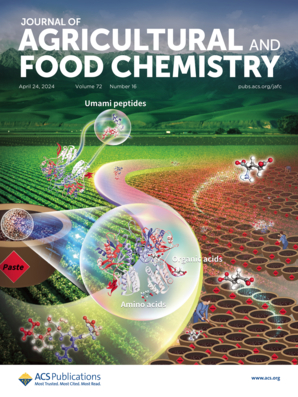Quinazoline Alkaloids for Plant Protection: Design, Synthesis, and Biological Evaluation of Novel Deoxyvasicinone Derivatives
IF 5.7
1区 农林科学
Q1 AGRICULTURE, MULTIDISCIPLINARY
引用次数: 0
Abstract
For many years, plant diseases brought about by viruses plus fungi have led to significant declines in crop yield as well as quality, highlighting the urgent need for the development of effective antiviral as well as fungicidal agents. Quinazolinone alkaloids have an important role in drug research and development (R&D). Herein, alkaloid deoxyvasicinone was chosen as the mother structure; deoxyvasicinone derivatives were designed, prepared, and evaluated for their antiviral and antifungal activities. The antiviral activity against tobacco mosaic virus (TMV) suggested most compounds displayed better inhibitory effects compared to ribavirin; especially, compounds 3a, 3d, 4, and 5 with significantly higher antiviral activities (AAs) (EC50 values: 113–208 μg/mL) than ningnanmycin (EC50 value: 229 μg/mL) emerged as novel antiviral leads. Compound 4 was chosen for the antiviral action mechanism study, which suggested that it can interfere with the formation of 20S coat protein (CP) discs, thereby affecting the TMV particles’ assembly. In vitro antifungal activity research suggested most compounds exhibited wide-spectrum fungicidal activities (FAs) at a test concentration of 50 μg/mL. Further pesticide-likeness research exhibited that compounds 3a, 3d, 4, and 5 showed pesticide-likeness with the potential to be developed as pesticide candidates. This research establishes a basis for the use of deoxyvasicinone alkaloids in green pesticides.

植物保护用喹唑啉类生物碱:新型脱氧水杨桃酮衍生物的设计、合成和生物学评价
多年来,病毒加真菌带来的植物病害导致作物产量和品质显著下降,迫切需要开发有效的抗病毒和杀真菌剂。喹唑啉酮类生物碱在药物研究和开发中具有重要作用。本文选择生物碱脱氧水杨桃苷酮为母结构;设计、制备了脱氧水杨桃酮衍生物,并对其抗病毒和抗真菌活性进行了评价。对烟草花叶病毒(TMV)的抑制活性表明,大多数化合物对烟草花叶病毒的抑制作用优于利巴韦林;特别是化合物3a、3d、4和5的抗病毒活性(EC50值为113 ~ 208 μg/mL)显著高于宁南霉素(EC50值为229 μg/mL),成为新的抗病毒先导物。选择化合物4进行抗病毒作用机制研究,表明化合物4可以干扰20S外壳蛋白(CP)圆盘的形成,从而影响TMV颗粒的组装。体外抑菌活性研究表明,大多数化合物在50 μg/mL的浓度下具有广谱杀真菌活性。进一步的农药相似性研究表明,化合物3a、3d、4和5具有农药相似性,具有开发候选农药的潜力。本研究为脱氧水杨碱类生物碱在绿色农药中的应用奠定了基础。
本文章由计算机程序翻译,如有差异,请以英文原文为准。
求助全文
约1分钟内获得全文
求助全文
来源期刊
CiteScore
9.90
自引率
8.20%
发文量
1375
审稿时长
2.3 months
期刊介绍:
The Journal of Agricultural and Food Chemistry publishes high-quality, cutting edge original research representing complete studies and research advances dealing with the chemistry and biochemistry of agriculture and food. The Journal also encourages papers with chemistry and/or biochemistry as a major component combined with biological/sensory/nutritional/toxicological evaluation related to agriculture and/or food.

 求助内容:
求助内容: 应助结果提醒方式:
应助结果提醒方式:


